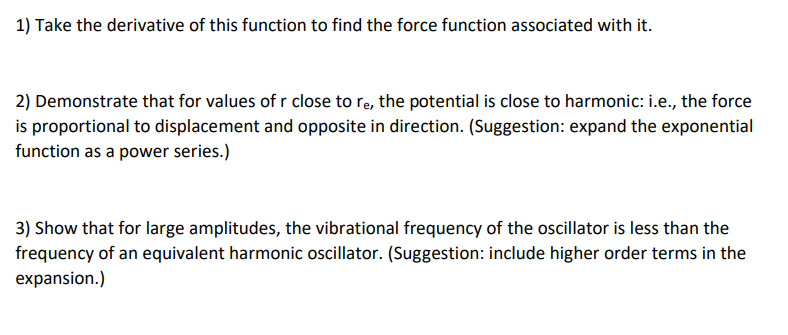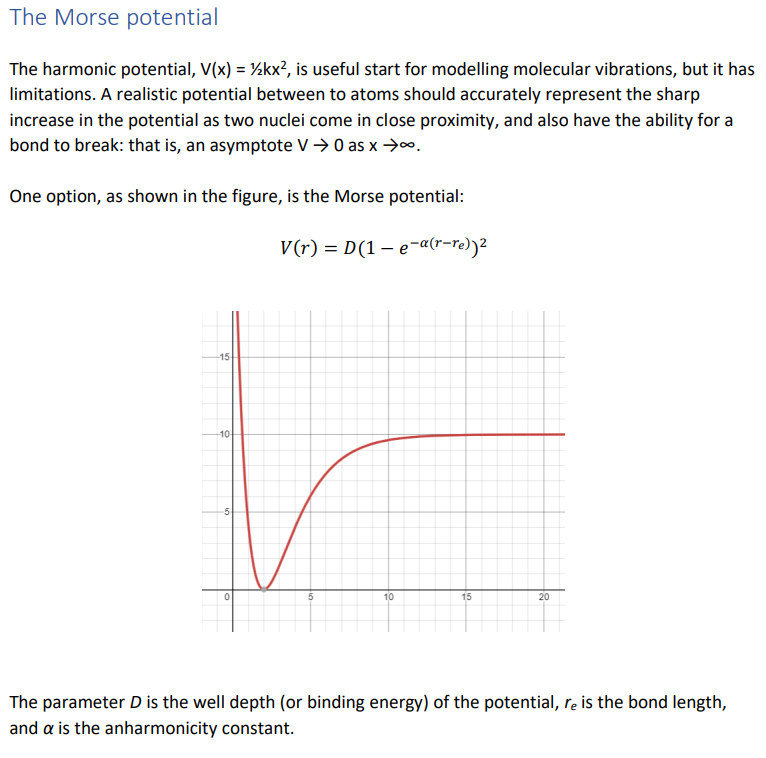1) Take the derivative of this function to find the force function associated with it. 2) Demonstrate that for values of r close to re, the potential is close to harmonic: i.e., the force is proportional to displacement and opposite in direction. (Suggestion: expand the exponential function as a power series.) 3) Show that for large amplitudes, the vibrational frequency of the oscillator is less than the
1) Take the derivative of this function to find the force function associated with it. 2) Demonstrate that for values of r close to re, the potential is close to harmonic: i.e., the force is proportional to displacement and opposite in direction. (Suggestion: expand the exponential function as a power series.) 3) Show that for large amplitudes, the vibrational frequency of the oscillator is less than the
Modern Physics
3rd Edition
ISBN:9781111794378
Author:Raymond A. Serway, Clement J. Moses, Curt A. Moyer
Publisher:Raymond A. Serway, Clement J. Moses, Curt A. Moyer
Chapter7: Tunneling Phenomena
Section: Chapter Questions
Problem 1P
Related questions
Question
and can you explain how you got the answer? It helps me understand the math

Transcribed Image Text:1) Take the derivative of this function to find the force function associated with it.
2) Demonstrate that for values of r close to re, the potential is close to harmonic: i.e., the force
is proportional to displacement and opposite in direction. (Suggestion: expand the exponential
function as a power series.)
3) Show that for large amplitudes, the vibrational frequency of the oscillator is less than the
frequency of an equivalent harmonic oscillator. (Suggestion: include higher order terms in the
expansion.)

Transcribed Image Text:The Morse potential
The harmonic potential, V(x) = ½kx?, is useful start for modelling molecular vibrations, but it has
limitations. A realistic potential between to atoms should accurately represent the sharp
increase in the potential as two nuclei come in close proximity, and also have the ability for a
bond to break: that is, an asymptote V →0 as x →00.
One option, as shown in the figure, is the Morse potential:
V(r) = D(1 – e-«(r=re))2
15
10
10
15
20
The parameter D is the well depth (or binding energy) of the potential, re is the bond length,
and a is the anharmonicity constant.
Expert Solution
This question has been solved!
Explore an expertly crafted, step-by-step solution for a thorough understanding of key concepts.
This is a popular solution!
Trending now
This is a popular solution!
Step by step
Solved in 2 steps with 2 images

Recommended textbooks for you

Modern Physics
Physics
ISBN:
9781111794378
Author:
Raymond A. Serway, Clement J. Moses, Curt A. Moyer
Publisher:
Cengage Learning

Classical Dynamics of Particles and Systems
Physics
ISBN:
9780534408961
Author:
Stephen T. Thornton, Jerry B. Marion
Publisher:
Cengage Learning

University Physics Volume 3
Physics
ISBN:
9781938168185
Author:
William Moebs, Jeff Sanny
Publisher:
OpenStax

Modern Physics
Physics
ISBN:
9781111794378
Author:
Raymond A. Serway, Clement J. Moses, Curt A. Moyer
Publisher:
Cengage Learning

Classical Dynamics of Particles and Systems
Physics
ISBN:
9780534408961
Author:
Stephen T. Thornton, Jerry B. Marion
Publisher:
Cengage Learning

University Physics Volume 3
Physics
ISBN:
9781938168185
Author:
William Moebs, Jeff Sanny
Publisher:
OpenStax